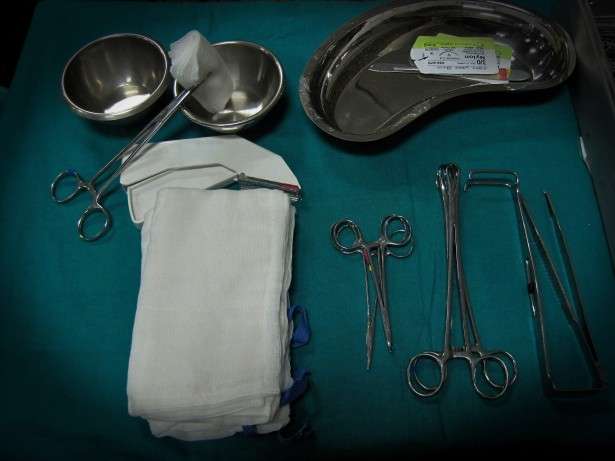Separation of conjoined twins presents surgical and ethical challenges

When a pair of conjoined twins was brought to MassGeneral Hospital for Children (MGHfC) for evaluation, the staff was presented with both the technical challenges inherent in what would be a complicated separation procedure and the ethical dilemma of choosing between options that would probably result in the death of either one or both children. How the team met those challenges is described in a "Case Records of the Massachusetts General Hospital" report in the Oct. 26 New England Journal of Medicine.
"The major challenges we faced were coordinating the large, multidisciplinary team - including pediatric general surgery, orthopedic surgery, plastic surgery, critical care, cardiology, radiology, nursing, palliative care, social work, ethics and the operating room staff - and confronting the ethical implications of an operation in which one twin was unlikely to survive," says Allan Goldstein, MD, MGHfC Surgeon-in-Chief. "We are fortunate to have the expertise and resources needed to manage this complex case."
The twin girls were born in a country in east Africa, and due to the probable complexity of any effort to separate them, the family was recommended to seek advice from specialists in the U.S. With the assistance of a non-profit organization based in the family's home country, requests were directed to around 20 U.S. hospitals, but only MGHfC agreed to take on the case. When the family arrived in Boston in mid-2016, the twins were 22 months old.
Initial examination revealed that the girls were connected at the abdomen and pelvis, with only three legs, one with a misshapen foot. Imaging studies revealed that they shared a single liver and each had one complete kidney, draining into a shared bladder, and one undersized kidney. The gastrointestinal tracts were fused below the upper small intestine, and pelvic structures were intermingled. While one twin who was larger than her sister was alert and interactive, the smaller twin was less active and less able to engage with caregivers.
Cardiac imaging revealed that the smaller twin had significant congenital heart defects. Her heart was undersized and had only one upper and one lower chamber, with underdeveloped blood vessels between the heart and lungs. The twins shared an arterial blood supply, with an enlarged mesenteric artery from the larger twin connecting to the abdominal aorta of the smaller twin. Blood flow through this connecting artery appeared to go both ways.
The smaller twin had symptoms of reduced oxygen delivery to her body upon initial examination, and over the next month she experienced several episodes of respiratory distress that required admission of the twins to the pediatric intensive care unit. During the second ICU admission, it was determined that the smaller twin was dependent on her sister's circulatory system and could not survive separation. But her continued deterioration made it likely she would die even if the twins remained conjoined, and her death would inevitably lead to the death of the other twin.
Because of the ethical questions raised by either option, the hospital's pediatric ethics committee was asked to review the situation. Their discussions determined that, while each twin should be regarded as a separate individual, there was little chance of saving the smaller twin, and not attempting separation would risk the life of the larger twin as well. The final decision was made by the twins' parents who - after comprehensive discussions with the clinical team and with the support of a religious leader - agreed that the surgery should proceed.
Goldstein says, "This complicated issue was masterfully managed by Dr. Brian Cummings, the pediatric critical care specialist who chairs our ethics committee. His role in this case was critically important and extremely valuable."
With considerable preoperative planning - including preparing for the challenges of administering anesthesia to two patients with a joined circulatory system, one with a compromised cardiopulmonary system - the 14-hour surgery went as expected. When the arterial connection was divided after separation of the pelvic structures, the smaller twin's blood pressure and oxygen levels began to drop, resulting in her expected and unavoidable death. Now more than a year later, the larger twin is thriving - eating, standing with assistance and developing as expected. She continues to receive physical therapy and will need additional operations to treat the malformation of her lower leg and foot.
At the MGH surgical grand rounds where the story of the twin's treatment was presented - the source of the "Case Records" report - their parents described the difficulties they had faced in Africa, both from the lack of available services and from the stigma associated with the twins' unusual condition. They expressed their appreciation for the consideration they received and the care provided to their daughter, who they said was "doing very well. Everyone here was united for our family's cause. We couldn't be prouder or happier with how we all came together for the well-being of our child."
Goldstein, professor of Surgery at Harvard Medical School, adds, "This case - sitting at the intersection of surgery and ethics - highlights the incredible skill, compassion and collaboration of the providers at MGH. Navigating this complex territory was challenging but worth it and extremely rewarding for everyone involved."
More information: New England Journal of Medicine (2017). DOI: 10.1056/NEJMcpc1706105
















